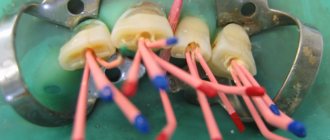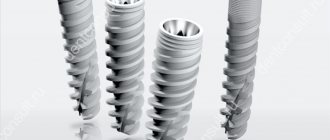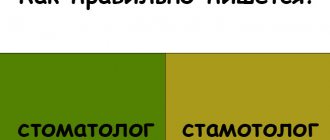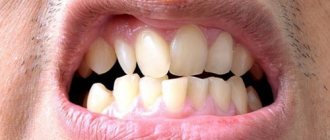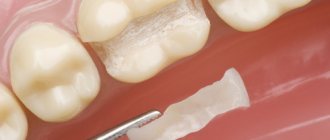July 12, 2018
When you go to see a dentist, do you think about what he uses to fill the root canals when treating caries, pulpitis or periodontitis? The editors of the UltraSmile.ru portal believe that every patient needs to have at least an approximate idea of this. After all, the condition of teeth and gums, the quality of treatment, and the longevity of the result depend on what material doctors use. Today in dental practice, gutta-percha is used to seal the root canals of teeth. Today we will try to find out why this material is so popular among doctors and patients.
From a scientific point of view
What is the meaning of the word "gutta-percha"? From a scientific point of view, this material was classified in 1843 and classified as a useful natural thermoplastic. In the second half of the 19th century, gutta percha was used for a variety of domestic and industrial purposes.
In particular, this material was needed as an insulating substance for submarine telegraph cables. Long before gutta percha was introduced into the Western world, it was used in a less processed form by the natives of the Malaysian archipelago to make knife handles, walking canes and other purposes.
The first European to discover this material was John Tradescant, who discovered it in the Far East in 1656. He called it "Mather's forest." Dr. William Montgomery, a medical officer in the Indian Service, introduced gutta-percha into practical use in the West. He was the first to recognize the potential of this material in medicine, and in 1843 he was awarded the gold medal of the Royal Society of Arts in London.
How to eat if you have gutaperchiness?
Due to the fact that with this pathological condition there is a heavy load on the joints of patients, they need to adhere to a diet, since excess weight can aggravate an already difficult situation:
- the diet should not contain too high-calorie foods;
- you should eat plenty of fruits and vegetables;
- The menu should include foods rich in calcium and other microelements necessary for the normal functioning of joint tissues.
Gutta-percha tree
In Malaysia, the tree is known as "taban" and people there traditionally used the hardened sap ("hanah") to make items such as molded handles for tools and knives. This natural latex, also called gutta-percha, is a very valuable product.
Palaquium gutta trees grow 5-30 m in height and are usually up to 1.5 m in diameter. The leaves are evergreen, alternate or spirally arranged, simple, entire, about 8-25 cm long each. They are glossy green above and often yellow or bluish below.
The flowers appear in small clusters along the stems, each flower having a white corolla with four to seven (mostly six) sharp lobes. The fruit is an ovoid berry 3-7 cm in diameter, containing from one to four seeds. In many species it is edible.
In Australia, gutta-percha is the common name specifically used for the tree Excoecaria parvifolia, which produces an aromatic, heavy, dark brown wood. It is also called "northern birch". This particular species is not related to the genus Palaquium.
Peculiarities
For many decades, scientists from around the world have been studying this disease. The results of numerous studies have shown that girls of African, Asian and Oriental origin often face the problem of gutaperchiness.
For example, if one of the parents has such a problem, then with a fifty percent probability the child born will face the same pathology.
Scientists have also been able to prove that hypermobility has a detrimental effect on the human muscular and skeletal system.
Due to excessive mobility, the joints are constantly subjected to excessive stress, and they become more fragile and are often injured.
To exclude the possibility of developing serious complications, children with this diagnosis will have to adhere to a certain lifestyle throughout their lives.
From a chemical point of view
What does gutta-percha mean? In the literal sense, it is made from gutta-percha. What kind of meterial is this from a chemical point of view? Its structure is a latex elastomer or a polymer made of isoprene or polyisoprene. While latex rubbers are amorphous in molecular structure, gutta-percha (transstructure) crystallizes, resulting in a stiffer consistency. Gutta-percha is an isoprene polymer that is soft when heated and can be easily cast into a variety of shapes that are precisely detailed.
Treatment
This pathological condition is incurable. Specialists can give this audience of patients recommendations regarding the correct lifestyle.
Such patients will be able to prevent the occurrence of serious complications, sprains and any types of injuries only if they follow the instructions of their attending physicians:
- Patients will be required to engage in physical therapy. They should perform a series of strength exercises that do not put heavy physical stress on the ligamentous apparatus. Through systematic exercise, patients will strengthen their muscle tissue. It is worth noting that before starting the exercises, they should contact physical therapy specialists who will develop individual training regimens.
- It is extremely important to closely monitor the condition of your joints throughout your life. To do this, patients will have to visit orthopedic doctors regularly.
- Experts recommend swimming.
- Patients whose pathology manifests itself in vivid forms need to undergo a course of physiotherapy: electrophoresis, amplipulse, phonophoresis, paraffin baths.
- If you experience severe pain and signs of progression of the disease, you will be advised to take medications that can strengthen cartilage tissue, normalize the process of collagen generation, relieve inflammation, and eliminate pain.
Use in dentistry
The same bioinertia that made gutta-percha useful for marine cables also came in handy for medical purposes, namely dentistry. This material is used in many surgical devices and in root therapy (obturation or filling the empty space within the root of a tooth after it has undergone endodontic therapy). Its physical and chemical properties, including inertness and biocompatibility, melting point, ductility and malleability, make it important in endodontics.
How to diagnose?
Parents may suspect the presence of hypermobility in their children based on characteristic signs.
Do you want to know how to treat stomatitis on the tongue in adults at home? Then we recommend reading the article located at the link. You can find out the answer to the question - how many baby teeth children should lose by following the link provided.
Such children usually experience the following pathological conditions:
- the skin becomes very thin and is damaged by any impact;
- hernias appear;
- strabismus may occur;
- defects are detected in the heart valves;
- hypotonicity is observed;
- the bones have significant defects;
- Maximum flexibility;
- Bruises appear on the body even from minor physical impact.
This clinical picture indicates the presence of genetic defects.
In the case when parents notice minor deviations in their children, then in this case it can be argued that they have hypermobility of a benign nature, and it should not cause any particular concern.
To identify the severity of the pathology, specialists need to carry out a number of diagnostic measures.
First of all, they determine the angles of flexion in the following joints:
- carpal;
- knee;
- elbows;
- hip;
- in the spinal column.
To carry out such specific measurements, experts use the Beighton scale.
If any deviations from the norm are detected, they will be able to claim that the examined patient has hypermobility.
In the process of carrying out diagnostic measures, doctors pay special attention to the following physiological parameters of patients:
- age category;
- gender;
- general condition.
Historical use
Being biologically inert and stable, this type of latex is a good electrical insulator with a high dielectric constant. Wood of many types is also valuable. The properties of gutta-percha were noticed by the Western world only in 1842, although the local Malay aborigines had been using it for many centuries. Allowing this liquid (juice) to evaporate and coagulate in the sun produces a rigid latex that can be flexible again when heated, but is not brittle, unlike rubber made before the discovery of vulcanization.
By 1845, telegraph wires insulated with gutta-percha were being produced in Great Britain. Latex served as an insulating material for early submarine telegraph cables, including the first transatlantic telegraph cable. Gutta-percha was especially suitable for this as it was not attacked by the marine plants or animals that had damaged previous submarine cables.
The material was the main component of Chatterton joint, used as an insulating sealant for telegraph and other electrical cables. Since 1930, polyethylene has replaced gutta-percha as an electrical insulator.
In the mid-19th century, gutta-percha was also used to make furniture, notably founded in 1847. When heated, the material could be molded into furniture, jewelry, or tableware. Some of these decorative Revival pieces were shown at the Great Exhibition in 1851 in Hyde Park, London.
No allergic reactions
As scientists managed to find out, the material is quite inert and non-toxic. This means that it is not capable of entering into any reactions with the human body. Gutta-percha is a guarantee that even in sensitive patients the risk of tissue irritation and negative reactions is minimal. All materials used in dentistry for the purpose of preserving natural teeth must meet the same selection criteria as gutta-percha. One of its few disadvantages is the lack of adhesion to the walls of the tooth. But this disadvantage is compensated by special cement compositions, root sealants and pastes, which are used in conjunction with gutta-percha points.
Using natural materials, does not cause allergies
What is a gutta-percha pin made of? In addition to gutta-percha itself, specialists use zinc oxide to create it. It gives strength to the structure, which helps strengthen significantly damaged teeth and use the pin as a reliable support for an artificial crown, if necessary. The content of this substance is about 70% of the entire structure. Antioxidants are also used as excipients.
Modern use
It was also used to make mourning jewelry because it was dark in color and could easily be molded into beads or other shapes. Pistol grips and shoulder pads were also made of gutta-percha, which gave them strength and durability. The guttie golf ball, which had a hard gutta-percha core, revolutionized the game.
This material remained the main industrial product in the twentieth century, but later began to be gradually replaced by superior synthetic materials. Despite its long history, gutta percha is still used today. Modern dentists continue to use it to fill root canals.
Affordable material cost
Dental treatment using gutta-percha is available to everyone today. The cost of installing material into the tooth canals can vary from 1 to 3 thousand rubles.
Previously, paste was placed in tooth canals as a filling material, but it tended to quickly dissolve, forming voids in which bacteria and pathogenic microflora easily multiplied. Methods of using gutta-percha in dentistry have brought the quality of service provision to a fundamentally new level. Thanks to this, long-term preservation of natural teeth has become possible.
Notice
: Undefined variable: post_id in
/home/c/ch75405/public_html/wp-content/themes/UltraSmile/single-item.php
on line
45 Notice
: Undefined variable: full in
/home/c/ch75405/public_html/wp-content /themes/UltraSmile/single-item.php
on line
46
Rate this article:
( 4 ratings, average: 5.00 out of 5)
pulpitis
"Gutta-percha": meaning
What is this concept? So, in the literal sense, gutta-percha is made from gutta-percha (natural rubber). In a figurative sense, this word has acquired a meaning associated with flexibility and elasticity. In relation to people, this definition began to be used and became a household name after D. V. Grigorovich wrote his sad story “The Gutta-percha Boy”.
This is a tragic story about a circus boy who was said to have no bones, he was so flexible and dexterous. From now on, people who are called gutta-percha are athletes with good stretching. It is achieved through long training. The gutta-percha woman is a gymnast who can do incredible things with her body.
The material is elastic and pliable
It is interesting that when translated from English, the first part of the word “gutta” means resin, the second “percha” is translated as island. The expression “gutta-percha” has stuck among the people; it is used to describe those whose character demonstrates flexibility and evasiveness in thinking and actions.
Elastic material seals tooth canals well
What are the benefits of gutta-percha in dentistry? This allows you to easily fill the entire tooth cavity and reliably seal its canals, as well as strengthen the filling. But provided that the dentist does his job efficiently and has no problems determining the length of the canals. In cases where the tooth canals were not completely filled, patients may face unpleasant consequences: the infection can easily penetrate into the pulp chamber, cause complications, and the tooth will have to be unfilled and re-treated.
Gutta-percha gait
What does gutta-percha mean? This word is now quite fashionable and in youth slang means flexible, beautiful, graceful. If we recall the words from the song of the singer Bianca - “With a gutta-percha gait we walk into Iarfor (nightclub) ... “.
Here we mean not so much elastic and flexible, but soft, swaying and graceful. You can sometimes hear about a person that he or she is such a gutta-percha. It can mean flexible and sexy. Although in the past the term was associated with rubber and gymnasts, it is now also synonymous with sexuality.
What is gutaperchiness?
Probably every person has heard such a phrase as “guta-perchia boy,” but not everyone understands the reason for its occurrence. This has been the name since ancient times for people who have congenital hypermobility of the joints.
Despite their plasticity and flexibility, this condition is considered by specialists as a connective tissue pathology.
But, if patients are provided with proper care by their loved ones, the consequences of the pathological condition will become less noticeable.
A couple of questions
If there is a fundamental security flaw in a design that can only be "fixed" by lowering the standards by which it is judged, is the design "safe"?
If the proponents of this supposedly safe scheme are aware of this flaw, but do not publicly disclose it to anyone (other than in controversial statements in blog posts), should it be considered fraud, bad faith, or simply lies by suppression?
If supposedly trustworthy people knew about this problem, but did not tell those who trusted them about it, how should this reflect on their authority and the authority of those who, in turn, supported them?
“But if the guard sees that the sword is coming and does not blow the horn to warn the people, and the sword comes and takes the life of one of them, then that person will be taken for his sin, and I will call the guard to account for this death " — Ezekiel 33:6
Paper-moderated, ink-cooled editor
It's not hard to understand why people fall for this. PoW promises them essentially a low-efficiency [7] system that delivers a specific outcome using methods that are clearly incomprehensible to the average user. PoS promises them a good system that produces the same result using methods that are about as incomprehensible.
People promoting PoS either don't know about the security properties of the technology they support, in which case they are clowns (whose advice on technology matters cannot be trusted), or they know (but don't tell you), in which case they are - scammers (whose recommendations in technological matters definitely cannot be trusted).
In any case, the fact that a person promotes PoS or takes seriously those who do should be enough to disqualify him from being considered an authority on any subject. The fact that this does not happen, and outright scammers are enthusiastically rehabilitated, is an indictment of the supposed “crypto community.”
“Nothing at stake”
In PoW, unscrupulous network participants are punished. The system that carries out this punishment is simple: they have wasted electricity; if they do not make the expected profit in cryptocurrency, they suffer losses. Only if the system actively decides to reward them will they recoup their costs.
In this way, punishment for dishonest behavior is guaranteed: the need to pay for electricity without receiving compensation. Due to the laws of physics, turning energy into heat increases entropy, and time cannot be turned back. The node cannot “unmine” the block and get its electricity back.
PoS, at its core, does not have the same system. As with the double-spending problem, anyone with a digital key can sign anything they want without any consequences. Therefore, they have to recreate a similar synthetic stimulus structure.
This is where the problem comes in: since their punishment is synthetic, it exists within the system. Since the penalty exists within the system, it can only affect what the system has control over—in this case, nodes' locked deposits. Therefore, once users withdraw their deposits, they become untouchable. This is the problem with “nothing at stake.” There will inevitably come a time when a node will be able to “unfreeze” all its deposits (translator’s note) and withdraw money. At this point the network has a problem:
- This key is valid for signing any number of versions of, say, block number 200, and there is no objective, in-system standard for determining which version is legitimate other than “the one that was published first.”
- The node can sign whatever it wants with this key without any consequences. There is no way to punish him because he does not risk anything [5].
Almost all systems try to solve this problem in the same way:
- If a node signs another version of the same block within a short enough period of time, "cut" its deposit (i.e. penalize it within the system).
- If a node signs another version of the same block, for example, a year later, simply ignore what happened.
Here's the problem: how do you know which version came first? If you were there from the very beginning and saw everything with your own eyes, then it's easy. But what if you just installed the client and your node is trying to sync? What happens if you are presented with two identical blocks and you have to decide which one to choose?
The whole point of the consensus mechanism was so that we could determine which transaction was first without personally observing it. This is why it is important to solve the problem of decentralized timestamping, thereby solving the problem of ordering transactions and, by extension, the problem of double spending.
In this case, it seems that our supposed consensus mechanism suffers from the double signature problem. Luckily, it solves this problem by solving the decentralized block timestamp problem, so it can solve the block ordering problem.
Hahaha, just kidding. This mechanism doesn't actually do the latter. To solve this problem you will need some other method:
“Based on all the arguments above, we can safely conclude that the threat of an attacker creating a fork from an arbitrarily large distance is unfortunately fundamental, and in all non-degenerate implementations this problem is fatal to the success of the PoS algorithm in the PoW security model. However, we can overcome this fundamental barrier with a small but fundamental change in the security model.” - Vitalik Buterin.
In other words: if you evaluate PoS within the same threat model as PoW, the former is fundamentally (and fatally!) insecure. Even his main supporters admit this. Only if we lower the level of security and make “minor, but nevertheless fundamental changes” to the security model, can it be called “secure”.
Origins of digital currency
“Digital signatures provide part of the solution, but the main benefits are lost if a trusted third party is still required to prevent double spending.” — Satoshi Nakamoto
https://www.21ideas.org/content/files/2021/12/bitcoin_ru.pdf
Once you have the file on your computer, despite what NFT proponents may believe, there is no way to stop people from copying it. If this file is your digital currency, you are facing a problem. If people can effectively CTRL-C -> CTRL-V your currency, that currency is worthless.[2]
The first step to solving this problem was to change the way we send funds. Instead of simply sending a computer file, users sent digital currency by signing it with a digital signature. This was a huge step forward, but it was not the final step - it did not solve the problem of double spending.
Essentially: if I have $1 worth of digital currency, nothing can stop me from trying to send the same $1 to two different people, thus turning it into $2. Unless both recipients can compare their incoming transactions to understand that they are being cheated, there is no way to solve this problem.
(For that matter, pure cryptography offers a partial solution to this problem. Some digital signature schemes cause the signing key to be lost if you try to sign two different things with the same key. However, a method for recovering the key is to perform a mathematical calculation on the two signatures (for this to happen, two signatures must be collected in one place by one person).
Before Bitcoin, people had been trying to solve this problem for decades. The DigiCash system was proposed by David Chaum in 1989, and it did solve this problem, but this solution came at the cost of centralization. All transactions went through a server called "mint" (albeit in an encrypted format), and this server, since it had a complete list of all transactions, could check them for double spending.
Thus, in 2007, the state of affairs in this area basically boiled down to the following choice: a centralized system without double spending or a decentralized system with it. Since a double spend currency system is by definition not a currency system, this effectively meant that all digital currency systems had to be centralized.
But Satoshi Nakamoto, the inventor of Bitcoin, had his own thoughts on this matter:
- If you require that all transactions be recorded in a ledger, you can (by definition) ignore transactions that are not recorded in that ledger. This means that you only have to worry about double spending within that registry.
- If two conflicting transactions appear in the ledger, the valid one will always be the one posted first.
- If you had what's called a "timestamp server" you could use it to figure out which transaction came first.
- We can create such a timestamp server by relying on the Proof of Work algorithm as described above.
More details: Using my node's local clock, I can check that new incoming blocks (described as "lottery tickets" in my analogy above) have the correct time. Having direct access to a series of blocks (the "blockchain"), I can threaten to refuse to accept transactions (rendering their money worthless) if these timestamps are not accurate, i.e. do not match my (local) clock. At this point, it seems I should apologize to the reader for describing this rather mundane process in such excruciating detail. But this is really necessary: to understand why a good mechanical watch is better than a decent Chinese [3] copy, it is not enough to look at the marketing materials, glossy brochures, and then finish with a quick glance at the case - “looks about the same, three hands and a dial” - and notice that they seem to keep time quite well. We have to take them apart and see what's inside.
For $2, it's probably a good deal.
Key points:
The whole purpose of the system is to display time accurately. Time is very, very important here. The significance of this cannot be overestimated.
PoW is a vital part of the system, but not the system itself. There are other details as well. And if you want to replace one part with another, it must, in fact, be the same part. In addition, it must have the same or better qualities.
Is PoS essentially the same thing? Does PoS have similar properties?
An option for careful tooth restoration if the crown has collapsed to the base
Modern dentistry allows you to preserve natural teeth even when they are quite damaged. It is quite natural that one has to work very carefully with such problematic units, because the service life of the restored teeth will depend on how well the doctor does his work. And here the stage of endodontic treatment and canal filling will be of decisive importance. Today, filling canals with gutta-percha pins is considered one of the most reliable methods. And at the same time very affordable. What kind of technology is this, what are its features and advantages? We invite you to consider further.
What is a pin
Before moving on to what gutta-percha pins are in dentistry, let's basically understand what a pin is. This is a kind of rod or structure that has the necessary hardness to become a support for a badly damaged tooth that needs restoration due to deep caries, pulpitis, and traumatic injuries. This support allows you to avoid tooth extraction, restore it and extend its service life. This rod is placed and strengthened in the root system; it can act as a support for an artificial crown or prosthesis.
Some people call not only pins, but also implants rods. Indeed, these two designs are somewhat similar to each other, because both allow for high-quality tooth restoration. But they also have fundamental differences: the implant is installed in the patient’s jawbone in the absence of a tooth and performs the functions of a root. The pin is installed in the root of a natural tooth in order to give it a chance to continue serving its owner.
Dental practice has long used metal and fiberglass rods. But due to their invariably solid state, they could not provide one hundred percent sealing of the channels and all their branches, and often led to complications. They were used in conjunction with filling pastes, which also shrink over time, dissolve and form voids. However, today doctors have found a more advanced method that allows them to achieve high quality indicators of endodontic treatment. Specialists began to use gutta-percha points for teeth in their work.
If it doesn't work, then how is it that it works?
We have already established that a system that works the way the promoters propose is literally impossible. This means that a system that actually works must sacrifice one of three things - either it 1) is not PoS (for example, hidden PoW), or it is 2) not decentralized, or 3) it is unable to achieve consensus.
In practice, however, there is often no clear boundary between these concepts. If the same people own all the tokens, control all the staking pools, manage the project and run all the full nodes, the attack is initially impossible. Everything is so centralized that from a distance a false impression of decentralization is created.
Remember the CAP theorem: When there is partitioning, you have to choose between consistency and availability, but when there is no partitioning, you get both without having to choose. If everyone who has the technical means to carry out an attack is close to the owner, the ship continues to sail. Or as David Gerard puts it:
The market doesn't care about Bitcoin's ideology behind decentralization. … The market treats centrally administered ICO tokens and centrally administered cryptocurrencies such as Ripple (XRP) as being in the same class as Bitcoin or Ether. The market wants what it wants, not what ideologists want from it. … Until:
the network remains secure enough to function
the price of ether does not break into a dead peak
ICO tokens continue to pump and dump
the newest crypto kittens don't clog up the network too much
and there will be no disasters more costly than those familiar in the current system, such as The DAO or the Parity wallet disaster
– the Casper update will be a good enough Proof of Stake that the community can live with it.
The Casper update doesn't have to be good enough for ideologues, it just has to function well enough for the market.
How PROOF OF STAKE works in theory
The basic idea of PoS is quite simple:
- Instead of purchasing $1,000 worth of mining hardware, participants can lock up $1,000 worth of cryptocurrency (“staking”).
- Instead of having to specify which blocks are valid through mining blocks, users can simply vote for them online and digitally sign their vote.
- Instead of the block with the most resources spent mining [4] winning, the block with the most votes wins.
- If the nodes' behavior turns out to be malicious, instead of losing the reward for their work, they will literally lose their entire locked stake - as if their entire PoW mining rig had burned down in a fire.
PoS proponents will argue that because these incentives are equal to or superior to those of a PoW system (true), the system is also as reliable or even superior to a PoW system (false). Their problem is that in addition to writing a list of desired incentives, they also need to create a system that will implement these incentives.
To use an analogy, it is akin to someone sitting down to design a building like this:
- First we draw the desired exterior.
- We draw the desired interior.
- We take basic measurements to ensure that the interior dimensions do not exceed the exterior dimensions.
- We decide that the house is ready for construction and send it to the builders for construction.
Of course, the most important part is missing - the structural system of beams and load-bearing walls, without which the building is not a building!
Our heroes must show in practice how their system will work, and this is where the fun begins.
